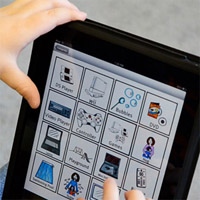Assistive technology brought to life
by Anthony Yuill
 The term assistive technology refers to a variety of assistive, adaptive and rehabilitative devices designed to assist individuals with disabilities or impairments. Hannah’s experience demonstrates how an expert occupational therapist, equipped with a profound understanding of the unique circumstances of their client, can identify precisely which technologies will help them, as well as oversee their successful implementation.
The term assistive technology refers to a variety of assistive, adaptive and rehabilitative devices designed to assist individuals with disabilities or impairments. Hannah’s experience demonstrates how an expert occupational therapist, equipped with a profound understanding of the unique circumstances of their client, can identify precisely which technologies will help them, as well as oversee their successful implementation.
Background
Hannah, 28, was involved in a traffic collision while driving home from work. At the time, she was a busy, active young woman with no history of medical difficulty. She enjoyed her job as a receptionist and had recently bought her own flat.
In the accident, she sustained significant head and neck trauma as well as a fracture to her spine, resulting in partial paralysis from the chest downwards and limited movement in her upper limbs. Hannah was hospitalised for a time, and underwent a number of physical rehabilitation interventions before being discharged.
Initial Rehabilitation
Hannah received significant physical rehabilitation from statutory services and her recovery proceeded at least as well as expected with her regaining weight bearing and mobility in her lower limbs. However, she continued to experience reduced movement in her upper limbs, along with difficulties with balance and dexterity that caused her to fall several times while in hospital.
She was initially discharged to her parents’ home, her family being concerned about the risk of further falls; at the same time, she was understandably impatient to regain her independence, return to work and enjoy a social life once again.
In due course Hannah returned to her flat and had a falls-detector and personal alarm installed, but it soon became clear that she was also experiencing significant memory loss and poor concentration, often forgetting to take her medication and attend appointments, and she reported continual fatigue and anxiety. In the process she became increasingly reliant on her partner, in ways which placed strains on their relationship despite his goodwill and determination to help her. Hannah had also yet to return to her place of employment, even though she was keen to do so.
Intervention
An occupational therapist’s assessment identified that the environmental adaptations to Hannah’s home already made by statutory services had enhanced her physical independence with many everyday domestic activities. The therapist was therefore able to turn his expertise towards addressing the other ongoing difficulties she was reporting, and a programme of advice and assistance with fatigue management, mitigating memory loss and reducing anxiety was judged beneficial.
First however, it was necessary to solve a number of practical problems in order to guarantee its successful implementation. Due to the remote location of Hannah’s home, it would have been difficult for her to access local rehabilitation centres on a regular basis, especially given her difficulties with fatigue.
She was therefore provided with a pre-programmed tablet device, allowing her to access a suitable online programme making use of voice-recognition software. The tablet was also expertly fitted to her wheelchair, and using Skype she was also able to remain in regular contact with her therapist as well as family and friends. The therapist also set up timed reminders on Hannah’s mobile, to prompt her to take her routine medication and remind her of upcoming appointments or programme milestones.
From the comfort of her home, Hannah was therefore able to address her fatigue and anxiety, and her concentration level and memory retention steadily improved as she worked through the programme. She became less dependent on her partner, and the associated strains on their relationship were relieved. In due course, she felt able to return to work and, liaising with the occupational therapist, her employers installed inexpensive voice recognition software on her computer to assist her in doing so. They also adapted her laptop according to recommendations made by the therapist, to allow remote access to the office so that she could work from home several days each week without loss of productivity.
In Hannah’s own words,
My rehabilitation has been helped by assistive technology in many different ways, including ones that might not have been available had my accident happened even five or ten years ago. It has made it possible for me to live more independently, and there are more options open to me in the future that I hope will let me become fully independent again.
If you would like to discuss further the way in which assistive technology can improve the lives of your clients, please contact one of our dedicated Client Managers at The OT Practice on 0330 024 9910.

